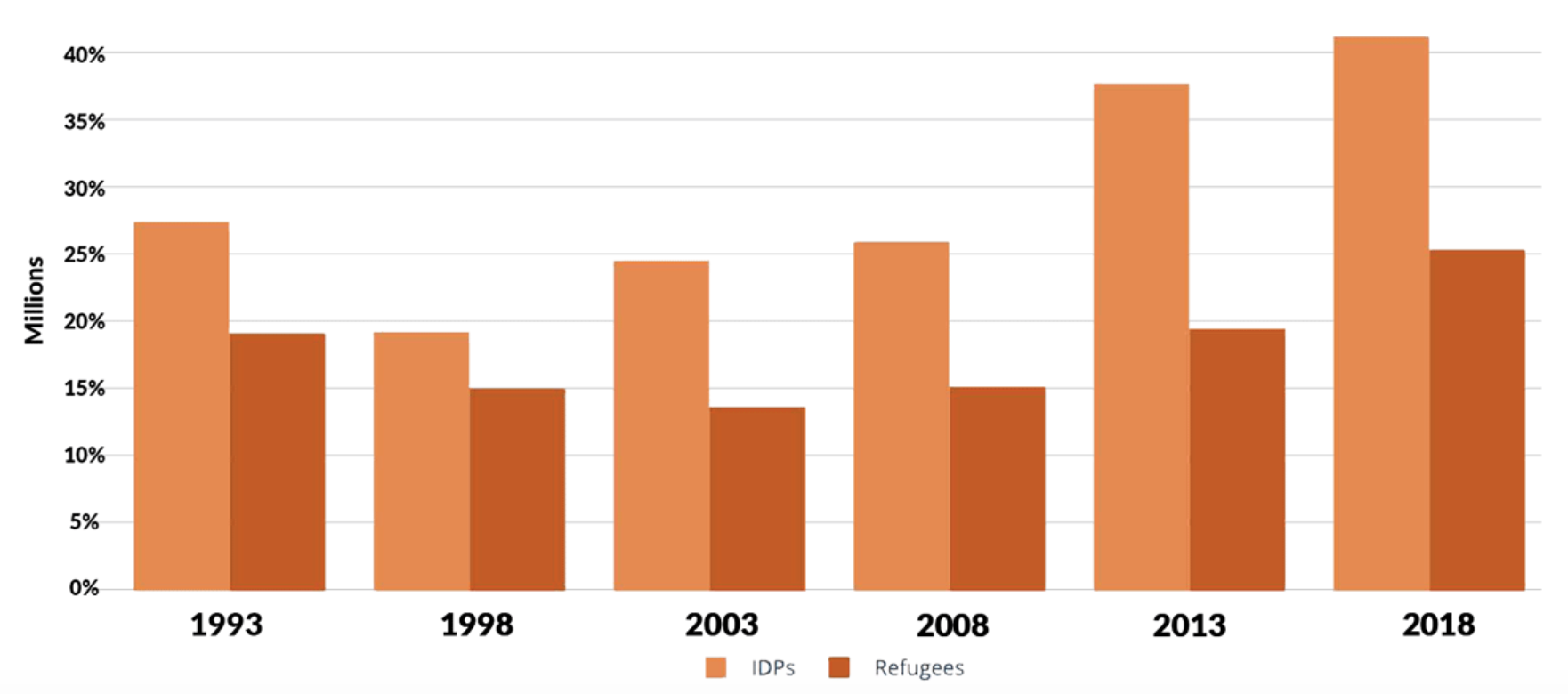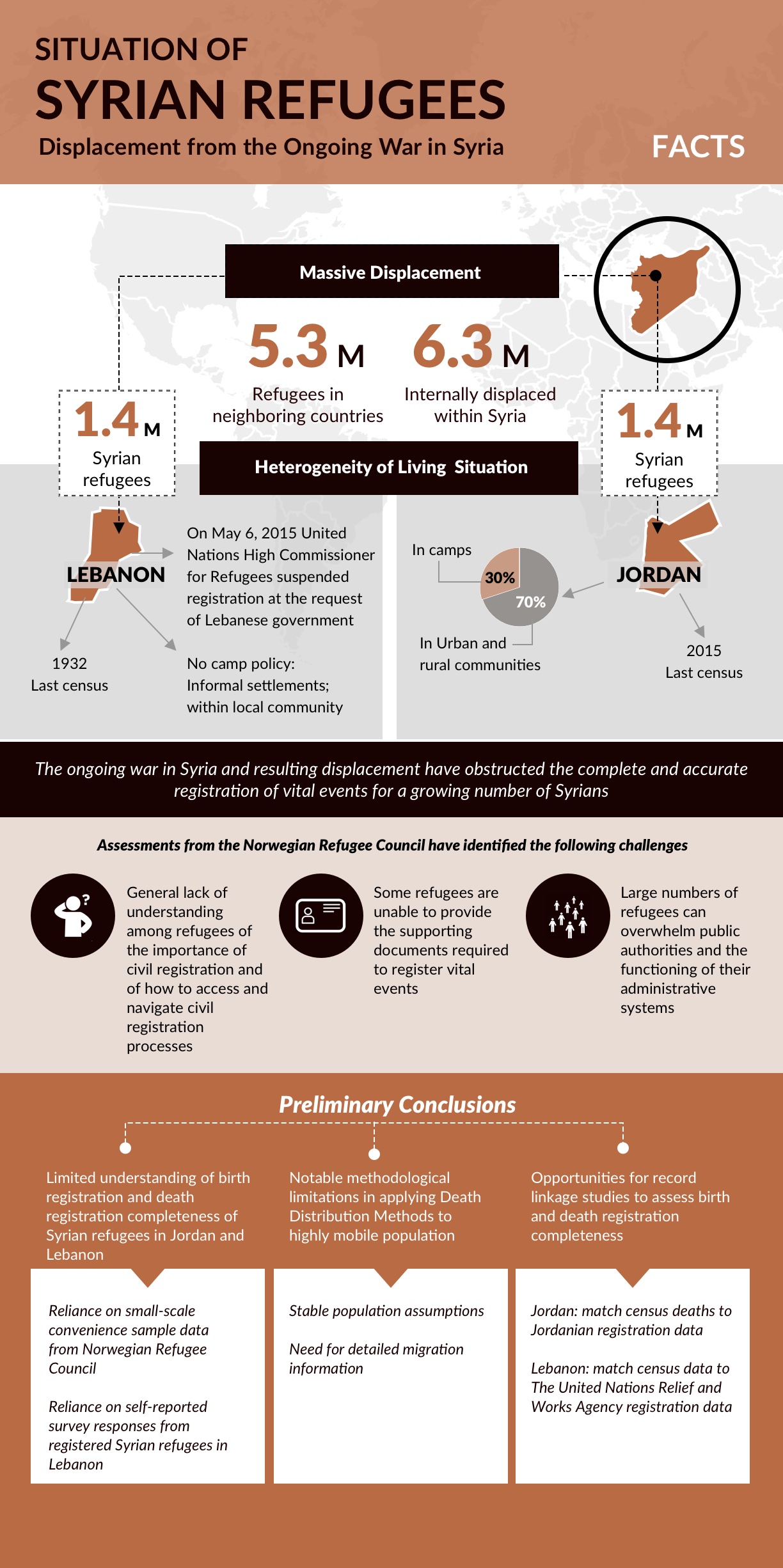Global, National, and Ethical Issues
41m
In 2018, more than 41 million people were internally displaced within the borders of their own countries as a result of conflict.
25.9m
Approximately 25.9 million people had been forced to cross international borders as a result of conflict or persecution.
3.5m
Approximately 3.5 million people were waiting for their asylum claims to be assessed.
- Low- and medium-income countries host many more refugees than high-income countries.
- U.S. policies on forced migration are changing very rapidly, and becoming more exclusionary; research is needed to understand the long-term consequences of these changes.
- Ethical issues arise at all points in the research process: conceptualization, research design, data collection, analysis, and communication.
Presentation from Michaela Hynie, York University
The Number of People Displaced By Conflict Has Never Been Higher
Internally Displaced Persons (IDPs) and Refugees, in millions
Presentation from Michaela Hynie, York University
The Number of People Displaced By Conflict Has Never Been Higher
Internally Displaced Persons (IDPs) and Refugees, in millions

Presentation from Michaela Hynie, York University
2018 Top Five Source Countries and Where They are Hosted
 |
|
| Turkey | 3.6m |
| Lebanon | 968k |
| Jordan | 667.2k |
| Germany | 514k |
| Iraq | 251.2k |
| Egypt | 129.7k |
| Sweden | 104.9k |
 |
|
| Pakistan | 1.4m |
| Islamic Republic of Iran | 951.1k |
| Germany | 116.7k |
 |
|
| Uganda | 784.5k |
| Sudan | 768.1k |
| Ethiopa | 445k |
| Kenya | 114k |
| DRC | 93.1k |
 |
|
| Bangladesh | 943.2k |
| Malaysia | 106.4k |
| Thailand | 97.4k |
 |
|
| Ethiopia | 256.4k |
| Yemen | 256.4k |
| Kenya | 251.4k |
Presentation from Michaela Hynie, York University
Most Refugees Remain in the Region of Country of Origin
Percent of Change in Regional Refugee Populations in 2018


Presentation from Michaela Hynie, York University
Issues in Research Design and Analysis of Migrant Integration
-
Understanding migrant integration requires combining comparable data collected in both destination and sending areas in order to:- assess the extent to which selection plays a role in explaining the trajectories of migrant populations,
- provide important comparisons on how migrants are faring in destinations,
- and better identify the degree of displacement for specific populations or individuals.
Presentation from Fernando Riosmena, University of Colorado at Boulder
-
Careful research of designs and methodologies can help identify the impact of migrant integration and refugee resettlement programs:- using administrative data to create longitudinal (over-time) profiles of migrants.
- using the difference-in-difference technique to estimate the effect of an intervention through the use longitudinal data.
- using regression discontinuity design to find causal effects of interventions.
Presentation from Aimee Chin, University of Houston
-
Combining different types of analytical, statistical, and qualitative techniques can shed light on why some groups fare better than others after a disaster, as well as the roles that economic development, social capital, information and communication, community competence, and the more abstract and complex concept of “culture” play in resilience and recovery.
Presentation from Mark VanLandingham, Tulane University
Types of Measurement as Indicators of U.S. Integration:
The National Academies of Sciences, Engineering, and Medicine report, The Integration of Immigrants into American Society, used a large number of indicators of integration, some of them controversial, such as the extent to which children were living in two-parent households. Other groups have developed scales of integration using multiple indicators, though many academics are reluctant to do this, due to the need to agree on the components of migrant and refugee well-being and then measure those components equally across societies or contexts, which can be difficult to do.
- Public opinion (native-born)
- Residential integration (foreign-born HH)
- Naturalization (1st generation)
- Civic engagement (1st gen. vs. others)
- Educational attainment (2nd vs. others)
- Employment (1st, 2nd & 3rd+ generation)
- Occupation (1st, 2nd & 3rd+ generation)
- Earnings (1st, 2nd & 3rd+ generation)
- Poverty (1st, 2nd & 3rd+ generation)
- Language (English) – (1st, 2nd & 3rd+ gen.)
- Mental & physical health (1st, 2nd & 3rd+ gen.)
- Crime rate (1st, 2nd & 3rd+ gen.)
- Family patterns
- two-parent household, inter-marriage
Presentation from Irene Bloemraad, University of California, Berkeley
Related work on immigration and integration from the National Academies of Sciences, Engineering, and Medicine:
- National Academies of Sciences, Engineering, and Medicine. 2015. The Integration of Immigrants into American Society. Washington, DC: The National Academies Press
- National Academies of Sciences, Engineering, and Medicine. 2017. The Economic and Fiscal Consequences of Immigration. Washington, DC: The National Academies Press.
- National Academies of Sciences, Engineering, and Medicine. 2018. Immigration as a Social Determinant of Health: Proceedings of a Workshop. Washington, DC: The National Academies Press.
Culture and Resilience
Mark VanLandingham (Tulane University) co-leads a project called Katrina@10, which is a set of five studies looking at differences in long-term recovery from Hurricane Katrina, where VanLandingham focuses on the Vietnamese community in the eastern part of New Orleans.
VanLandingham suggests that culture was the key to their resilience. The Vietnamese in New Orleans shared a common history and a common set of events that their non-Vietnamese neighbors did not share, which gave them a view of the world, or a way of interpreting it, that distinguished them from the other groups.
Resilience A process of linking a set of adaptive capabilities to a positive trajectory of functioning and adaptation after a disturbance, with the dimensions of economic development, social capital, information and communication, and community competence.
Culture Symbolic systems of beliefs, values, and *shared understandings that render the world meaningful and intelligible for a particular group of people.
*Shared understandings include:
Narratives: The telling, re-telling and refining of key elements of a group’s common history.
Symbolic boundaries: Serve to distinguish members of the group from outsiders.
Frames: Perspectives or orientations, similar to a lens or filter through which we view and interpret our social world.
Cultural toolkits: Repertoires of behavior (coping strategies) that vary systematically among groups” is missing a period at the end.

Conclusions
- Culture will influence the recovery trajectory for many forced migrants.
- If culture is to be effectively leveraged as a useful construct in disaster research, ways to quantitatively measure it should be explored.
Presentation from Mark VanLandingham, Tulane University

Presentation from Marwan Khawaja, United Nations Economic and Social Commission for Western Asia [ESCWA]
Take-Aways
- U.S. policies on forced migration are in a state of flux and becoming more exclusionary, and research will be needed to understand the long-term consequences of these changes. [Donald Kerwin, Center for Migration Studies of New York]
- Most of the world’s refugees are hosted in developing countries, where statistical systems tend to be weaker and there are greater challenges to measuring refugees and internally displaced persons (IDPs). [Romesh Silva, Health and Social Inequalities at the United Nations Population Fund]
- One way to better understand the experiences of forced migrants is to not treat them as separate from other types of migrants. Research has, with a few exceptions, overlooked what happens before arrival and resettlement, and has not investigated such factors as coercion, natural disasters, or environmental factors as drivers of migration. Remedying this research gap could entail adding questions to surveys, increasing subsample sizes, talking to non-migrants as well as migrants, broadening geographic coverage, leveraging administrative data, and analyzing data in new ways. [Holly Reed, Queens College, City University of New York]
Get the Workshop Proceedings
SOURCE: NASEM. 2020. Forced Migration Research: From Theory to Practice in Promoting Migrant Well-Being: Proceedings of a Workshop.
Statements, recommendations, and opinions expressed are those of the individual participants. They are not necessarily endorsed by the National Academies of Sciences, Engineering, and Medicine and should not be construed as reflecting any group consensus.
Sponsors
Robert Wood Johnson Foundation
The Andrew W. Mellon Foundation
President’s Fund

